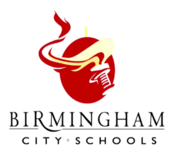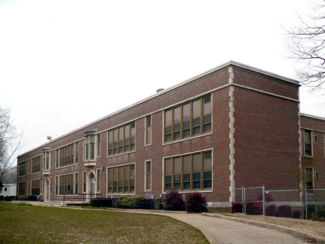Birmingham City Schools
Birmingham City Schools is the public school system for the City of Birmingham, administrated by the Birmingham Board of Education and led by Superintendent Mark Sullivan.
The system currently operates 42 schools with an enrollment of just under 20,000 students, and more than 2,700 certified and classified employees. Its annual budget is approximately $302 million.
History
Founding
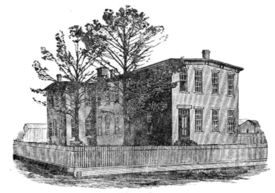
Birmingham's first public school was the Free School established in 1874 under the leadership of John T. Terry and James Powell. Despite its name, the trustees found it necessary to charge a nominal fee to students for a number of years in order to meet their budgets. That school, renamed "Powell School" became a high school when the next school were constructed in 1883. John H. Phillips became superintendent of schools that year and, two years later, oversaw the formation of the first Birmingham Board of Education, taking responsibility for schools out of the direct purview of the Mayor and Board of Aldermen.
Growth
Numerous surrounding suburbs and unincorporated areas, most poorly-served with public schools, were annexed into Greater Birmingham in 1910. The city issued $200,000 in bonds in 1915, and an additional $100,000 after Central High School was lost to fire in 1918. Those funds fueled a major campaign to construct new schools, which was interrupted by U.S. involvement in World War I. Once the program resumed in the early 1920s, the need for new schools was dire.
Consultant William Ittner of St Louis, Missouri worked with school officers and local architects to develop a "type" for the new schools to be constructed. The system moved from a "7-4" plan to a "6-3-3" model with elementary, middle and high schools. All of the schools were planned with "enriched facilities" which included space for physical education, domestic sciences, and laboratories and shops for science and manual education, along with libraries, theaters and cafeterias.
A 1923 study recommended a city-wide network of neighborhood schools. The city approved an additional $500,000 in bonds and Superintendent Charles Glenn and board chairman Erskine Ramsay charted a building campaign which replaced existing frame structures and temporary rented facilities with massive red-brick school buildings, many of which were designed by noted architects David O. Whilldin and Warren, Knight & Davis. As the growth of the "Magic City" continued through the decade, the building program was expanded to try to keep pace. A second 1927 study led to another bond issue and more new schools. By then, Birmingham's segregation laws had been enacted, creating numerous discrete neighborhoods that soon had their own schools.
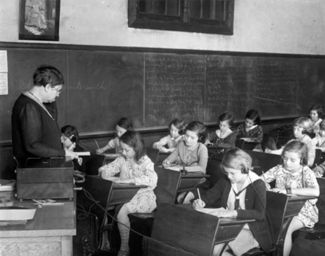
In 1952 an assessment of Birmingham's school resources found that 95% of children residing in the city attended one of the the 70 schools in the system. The study suggested several new schools be built to accommodate the "baby boom" generation. By 1961 forty-one new buildings had been completed, including several new neighborhood schools as well as auditoria or gymnasiums at existing schools.
Desegregation
On September 9, 1957, three years after the U. S. Supreme Court had ruled segregated schools unconstitutional, Alabama Christian Movement for Human Rights president Fred Shuttlesworth accompanied a group of four black children and their parents to Phillips High School in an attempt to enroll them as the school's first black students. The group was met by a mob of Klansmen armed with chains, clubs and brass knuckles. Shuttlesworth's wife, Ruby, was stabbed in the hip and his daughter, Ruby Frederika, suffered a broken ankle in the melee. Badly beaten, Shuttlesworth himself spoke that same night to urge continued non-violence on the part of black protesters, even in the face of klan and police brutality.
The suspects charged in the beating saw their charges dropped, while the lawsuit against the city filed by Shuttlesworth failed all the way to the Supreme Court, which upheld Birmingham's rule giving discretion over pupil placement directly to school superintendents.
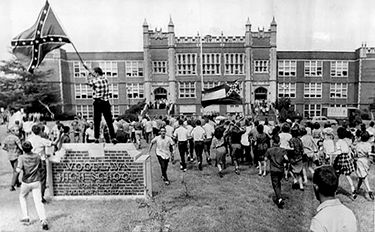
A lawsuit filed on June 17, 1960 by barber James Armstrong set the stage for court-ordered desegregation of Birmingham City Schools. The court issued a desegregation plan that went into effect in September, 1963. Graymont Elementary School was the first white school to have a black student in attendance, on September 4. A bomb which exploded that night at the home of Civil Rights activist Arthur Shores provoked the school system to close temporarily. When schools reopened on September 9, Alabama state troopers acted under orders from Governor George Wallace to prevent the black children from entering the schools. President Kennedy responded by sending the National Guard to escort transfers into West End High School and Ramsay High School on September 10. Five days later, the 16th Street Baptist Church was bombed, killing four young girls.
The system's flagship, Phillips High School, finally admitted its first African American students, (Lillie Mae Jones, Minnie Lee Moore, and Patricia Patton) on September 3, 1964. Integration of neighborhood elementary schools proceeded through the rest of the decade, with students from the all-Black Dudley School moving into an expanded Inglenook Elementary School as late as 1969.
Meanwhile, the 1960s saw rapid white flight from Birmingham into the over the mountain suburbs and other independent municipalities, reducing overall enrollment from 70,000 to 43,000 in 20 years while the percentage of African America students in the system rose from 50 percent to 80 percent.
Armstrong's suit was finally dismissed in 1983 by U. S. District Court judge J. Foy Guin. He determined that the system had demonstrated that its magnet school programs had attracted enough black students to formerly white schools to achieve "racial mix goals" without forced busing.
Consolidation
The city school system has declined in enrollment since the 1970s when 60,000 to 70,000 students filled the halls. In Fall 2004 the system lost more than 2,000 students from the year previous, then another 1,565 in 2005, 1,080 in 2006, 1,343 for 2007 and 433 for 2008. The number of students determines, in large part, the amount of state funding given to the system.
Superintendent Mims initially said that approximately 10 schools will be recommended for closure before the Fall 2007 school year. In April 2007 it was proposed that L. Frazier Banks Middle School, Curry Elementary School and Kennedy Alternative School would close, along with the McCaw School for students with severe behavioral problems and the Eureka Center, housing the system's Family Literacy Center. Banks closed in December 2006 while Curry and Kennedy were closed during the summer of 2007. Mims said that he would wait until after Labor Day 2007 to make recommendations for further school closures.
In January 2008 Mims presented a revised school-reorganization plan to the board. Under that proposal a total of 18 schools would close over the following four years. Among the changes to the plan, Glenn Middle School and Norwood and Gibson Elementary Schools would remain open while Wilson Elementary School and Putnam and Center Street middle schools would close. Ramsay High School would be converted into a magnet middle school while an expanded Parker High School would accommodate students from Ramsay.
In February 2008 Mims was placed on leave and Barbara Allen took over as acting superintendent. She held further public meetings and then presented a consolidation plan to the board which was approved on February 26. Under the approved plan, Hayes and West End High Schools would close in the summer of 2008 along with Kingston K-8 School, McElwain, and Oliver Elementary Schools. In 2009 Kirby Middle School would close while a new Hudson K-8 School was created and Norwood Elementary School expanded to K-8. In 2010 Wilson, North Birmingham and Gibson Elementary Schools would close while a new K-8 school opened at the Hayes High School site. In 2011 Hill, Going, Arthur, Price, Powderly and Wenonah Elementary Schools would close, along with A. G. Gaston K-8 School. Meanwhile, new schools would be created in Oxmoor Valley, Wylam, and Jones Valley.
Recent construction
Despite the drop in enrollment and a shortage of revenues for school operations, the system has significant resources for capital projects. Based on its 2004 enrollment, Birmingham City Schools were given a $331 million share of the Jefferson County School Construction Fund, a $1.1 billion bond issue financed by a county-wide sales tax increase.
The Board voted on January 23, 2007 to contract with Volkert & Associates of Mobile to oversee construction management for all capital projects planned using those funds. On April 22 the Board approved a $283 million construction plan which would cover construction of 10 new schools and the renovation or expansion of 13 others. The plan would provide $27.8 million for athletic facilities. $82.5 million would be used for construction 6 new elementary schools. $46.25 would cover construction of three K-8 schools, and $54 million would be spent on a new campus for Huffman High School. On May 13 the Board approved architectural contracts for the projects.
In moving toward construction, the board was eager to settle various property disputes with the City of Birmingham. The city loaned the system $3 million in April 2007 as a bailout to fund teacher buyouts. In return certain unused school properties were ceded to the city. At the same time some schools had been constructed on land to which the city hed the title, and the board wanted to take clear ownership before constructing new buildings.
Later developments
In March 2011 Superintendent Craig Witherspoon outlined challenges and strategies for the upcoming years. At the time, the system was facing a $23 million deficit which he hoped to address with early retirements, cuts to central office staff, and additional school closures. At the same time, he planned to increase participation in Advanced Placement courses; pursue an International Baccalaureate program in the system; and establish career academies with special training in engineering, finance, information technology and teaching. Six of the city's seven high schools were designated as career academies beginning in Fall 2011.
Some of those initiatives paralleled goals of the Blueprint Birmingham regional economic development campaign and were supported by the Birmingham Education Foundation which raises funds for teacher and staff training, as well as programs for parents.
In 2012 the Alabama Department of Education began investigating the operation of the school system, and specifically the leadership of the Birmingham Board of Education. They reported that the system was bloated with administrators, many of whom were hired by former superintendents and remained on when those superintendents were replaced while others had been promoted to the central office from tenured teaching positions. On June 27 the State took over operation of the system following the Board's failure to approve a cost-cutting plan to comply with a state law that requires systems to maintain cash reserves equal to one month's operating expenses. The district resumed direct control of the school system in mid-2015.
Effective March 16, 2020 all Birmingham City Schools closed as part of a state-wide shutdown aimed at slowing the spread of the SARS-CoV-2 virus, which had become a worldwide pandemic. Schools continued to prepare and distribute packaged take-home meals for students during the shutdown. As growing case counts indicated continuing community spread of the virus through the summer, interim superintendent Mark Sullivan announced that in-person instruction would be delayed for at least 9 weeks in the fall. The system distributed internet-capable devices and personal wifi hotspots to students, and resumed take-home meal service.
In 2021 the system was awarded $199,230,886 ($9,556/student) in federal Elementary and Secondary School Emergency Relief (ESSER) funds tied to the COVID-19 pandemic. Some of those funds were used for "Intersession" programs during fall and spring breaks, designed to help students who had fallen behind due to disruptions to "catch up".
In 2022 the system expanded a conflict resolution program which had been tested at Carver High School to all students in grades 9 through 12.
Enrollment
year students %change 1932–1933 | 47,000 | 1958-1959 | 69,000 | 1960-1961 | 70,000 | 1961-1962 | 72,083 | 1962-1963 | 72,612 | +0.7% 1964-1965 | 74,382 | 1965-1966 | 73,706 | -0.9% 1974-1975 | 54,000 | 1983-1984 | 43,000 | 2002-2003 | 37,520 | 2003-2004 | 36,029 | -4.0% 2004-2005 | 34,275 | -4.9% 2005-2006 | 32,145 | -6.2% 2006-2007 | 31,065 | -3.4% 2007-2008 | 29,736 | -4.1% 2008-2009 | 28,393 | -4.5% 2009-2010 | 27,525 | -3.1% 2010-2011 | 26,748 | -2.8% 2011–2012 | 25,795 | -3.6% 2012-2013 | 25,005 | -3.1% 2013-2014 | 24,877 | -0.5% 2014-2015 | 25,363 | +2.0% 2015-2016 | 25,454 | +0.4% 2016-2017 | 24,859 | -2.3% 2017-2018 | 23,772 | -4.4% 2018-2019 | 23,341 | -1.8% 2020–2021 | 21,597 | -7.4% 2021–2022 | 21,163 | -2.0% 2022–2023 | 19,921 | -5.9%
School attendance has also lagged in Birmingham City Schools, especially following the initial wave of the COVID-19 pandemic. In 2023 the system reported that around 23% of students were chronically absent (compared to a statewide average of 18%),
In part because state funding is tied to attendance, the system and City of Birmingham have made extra efforts to insure students are appearing for class. In addition to enforcing truancy laws, the city and Housing Authority of the Birmingham District developed a program to provide a cash award to selected families in public housing whose children have perfect attendance records.
Superintendents
- This list is incomplete. You can help Bhamwiki by expanding it.
- John H. Phillips, 1883–1921
- Charles Glenn, 1921–1942
- L. Frazier Banks, 1951–1959
- Theo R. Wright, 1969–1966
- Raymond Christian, 1966–1972
- Henry Sparks (acting), 1972–1973
- Wilmer Cody, 1973–1983
- John Cantelow II (interim), 1983
- Walter G. Harris, –1988
- Cleveland Hammonds, 1988–1994
- Ed LaMonte (interim), 1996
- Johnny E. Brown, 1998–2002
- Wayman Shiver Jr, 2002–2006
- Stan Mims, 2006–2008
- Barbara Allen (interim), 2008–March 2010
- Craig Witherspoon, March 2010–December 31, 2014
- Spencer Horn (interim), January 1–June 30, 2015
- Kelley Castlin-Gacutan, July 1, 2015–September 21, 2016
- Larry Contri (interim), September 21, 2016–May 2, 2017
- Lisa Herring, May 2, 2017–May 2020
- Mark Sullivan (interim), May–August 2020
- Mark Sullivan, September 2020–
Schools
The Birmingham School district is currently composed of 60 schools, divided into 9 districts and 5 clusters. The system's high schools include Carver High School, Huffman High School, Jackson-Olin High School, Parker High School, Ramsay High School, Wenonah High School, and Woodlawn High School.
References
- Ittner, W. B. (July 1922) "Modern Schools in the South: The Present and Future Birmingham Schools". School Board Journal. Vol. 65, No. 1
- Birmingham Public Schools (1931) Report of Progress, Birmingham Public Schools: September 1, 1921 to August 31, 1931 - accessed via Birmingham Public Library Digital Collections
- Dillon, Elsie H. (1972) A Brief History of Birmingham Public Schools, Centennial Edition, 1883-1972.
- Report of Progress on Birmingham City Schools, 1921-1931
- "Birmingham desegregation 'best handled'" (November 1, 1983) Associated Press/Times Daily
- Birmingham Historical Society (February 2008) "Cataloguing School Closures." Birmingham Historical Society Newsletter
- Hickerson, Patrick (July 28, 2006) "Pupil loss may cost schools $3 million". The Birmingham News
- Leech, Marie (January 24, 2007) "Board extends Volkert contract for construction management." The Birmingham News
- Leech, Marie (April 24, 2007) "Birmingham school board OKs closing buildings, may fire 176 on Monday." The Birmingham News
- Leech, Marie (August 22, 2007) "System loses 1,000-plus students." The Birmingham News
- Nance, Rahkia (November 1, 2007) "City schools lose students; slight changes in other areas." The Birmingham News
- Leech, Marie (December 24, 2007) "14 buildings for sale in '08." The Birmingham News
- Leech, Marie (January 31, 2008) "Birmingham city school closing plan changes for third time." The Birmingham News
- Leech, Marie (February 27, 2008) "Birmingham Board of Education approves plan to close 16 schools, narrowly avoids state takeover." The Birmingham News
- Stock, Erin (April 23, 2008) "New schools, construction slated for Birmingham schools." The Birmingham News
- Stock, Erin and Joseph D. Bryant (May 20, 2008) "Birmingham mayor, council, school system feud over property issues." The Birmingham News
- Crawford, Cindy F. (March 22, 2011) "Witherspoon reflects on first-year challenges, future opportunities." Birmingham Business Journal
- Leech, Marie (June 3, 2012) "Birmingham schools' finance reform hampered by bloated central office." The Birmingham News
- Leech, Marie (June 26, 2012) "Alabama Department of Education to take over Birmingham schools after Birmingham Board of Education decision." The Birmingham News
- Pelfrey, David (August 9, 2012) "Failing Grades: The Decline and Fall of Birmingham City Schools." Black & White
- Stein, Kelsey (June 11, 2015) "Birmingham City Schools officially released from state intervention." The Birmingham News
- Steward, Ameera (January 3, 2019) "Significant progress for Birmingham City Schools, according to state report card." The Birmingham Times
- Beahm, Anna (July 22, 2020) "Birmingham City Schools going virtual for first quarter." The Birmingham News
- Crain, Trisha Powell (October 25, 2021) "Alabama schools got $3 billion in federal COVID relief money. Where did it go?." The Birmingham News
- Jackson, Lauren (August 23, 2022) "Birmingham city schools seeing more student enrollment than this time last year." WBRC.com
- Griesbach, Rebecca (December 6, 2022) "Birmingham schools plan $1 million for conflict resolution, $7 million for pre-K center projects." AL.com
- Bookman, Alaina (January 25, 2024) "Birmingham offers money to parents who get students to school every day." AL.com
External links
- Birmingham City Schools website
- Birmingham City School District Demographic Dashboard at nces.ed.gov
- Map of Birmingham City Schools locations on maps.google.com
- List of school closures and consolidations compiled by the Birmingham News
